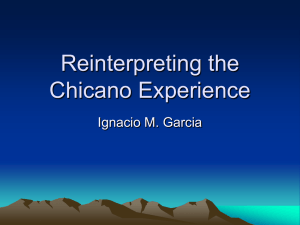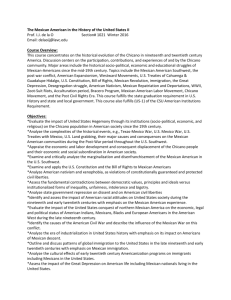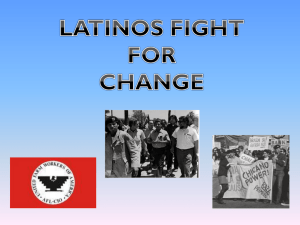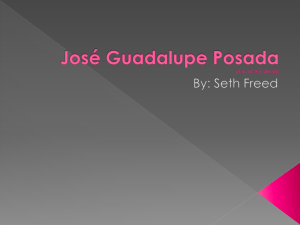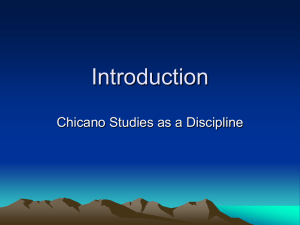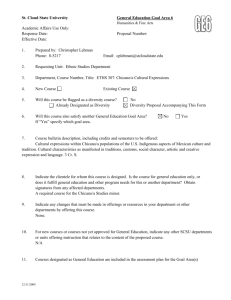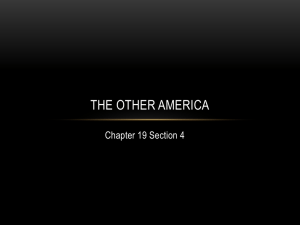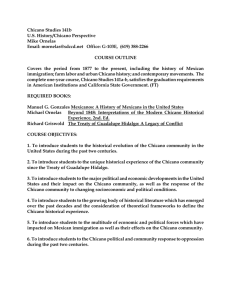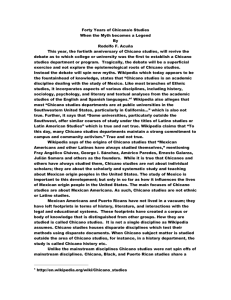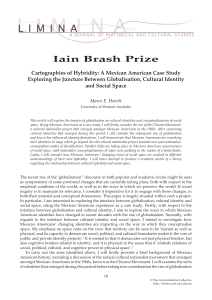The Mexican American in the History of the United States II Prof. I.J.
advertisement
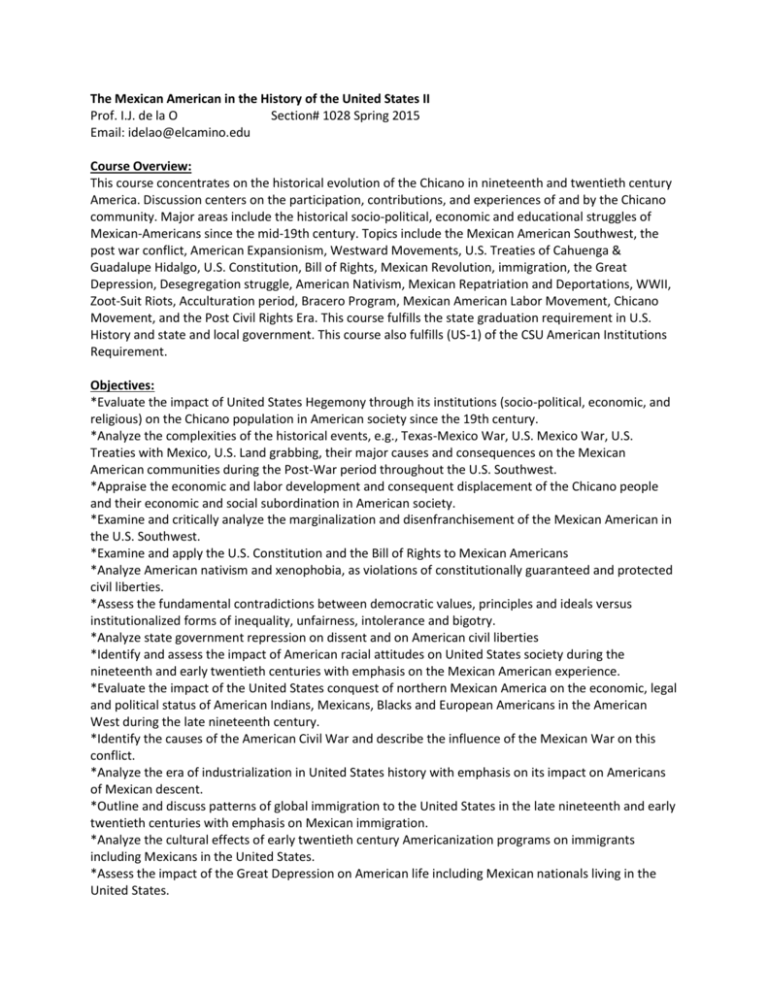
The Mexican American in the History of the United States II Prof. I.J. de la O Section# 1028 Spring 2015 Email: idelao@elcamino.edu Course Overview: This course concentrates on the historical evolution of the Chicano in nineteenth and twentieth century America. Discussion centers on the participation, contributions, and experiences of and by the Chicano community. Major areas include the historical socio-political, economic and educational struggles of Mexican-Americans since the mid-19th century. Topics include the Mexican American Southwest, the post war conflict, American Expansionism, Westward Movements, U.S. Treaties of Cahuenga & Guadalupe Hidalgo, U.S. Constitution, Bill of Rights, Mexican Revolution, immigration, the Great Depression, Desegregation struggle, American Nativism, Mexican Repatriation and Deportations, WWII, Zoot-Suit Riots, Acculturation period, Bracero Program, Mexican American Labor Movement, Chicano Movement, and the Post Civil Rights Era. This course fulfills the state graduation requirement in U.S. History and state and local government. This course also fulfills (US-1) of the CSU American Institutions Requirement. Objectives: *Evaluate the impact of United States Hegemony through its institutions (socio-political, economic, and religious) on the Chicano population in American society since the 19th century. *Analyze the complexities of the historical events, e.g., Texas-Mexico War, U.S. Mexico War, U.S. Treaties with Mexico, U.S. Land grabbing, their major causes and consequences on the Mexican American communities during the Post-War period throughout the U.S. Southwest. *Appraise the economic and labor development and consequent displacement of the Chicano people and their economic and social subordination in American society. *Examine and critically analyze the marginalization and disenfranchisement of the Mexican American in the U.S. Southwest. *Examine and apply the U.S. Constitution and the Bill of Rights to Mexican Americans *Analyze American nativism and xenophobia, as violations of constitutionally guaranteed and protected civil liberties. *Assess the fundamental contradictions between democratic values, principles and ideals versus institutionalized forms of inequality, unfairness, intolerance and bigotry. *Analyze state government repression on dissent and on American civil liberties *Identify and assess the impact of American racial attitudes on United States society during the nineteenth and early twentieth centuries with emphasis on the Mexican American experience. *Evaluate the impact of the United States conquest of northern Mexican America on the economic, legal and political status of American Indians, Mexicans, Blacks and European Americans in the American West during the late nineteenth century. *Identify the causes of the American Civil War and describe the influence of the Mexican War on this conflict. *Analyze the era of industrialization in United States history with emphasis on its impact on Americans of Mexican descent. *Outline and discuss patterns of global immigration to the United States in the late nineteenth and early twentieth centuries with emphasis on Mexican immigration. *Analyze the cultural effects of early twentieth century Americanization programs on immigrants including Mexicans in the United States. *Assess the impact of the Great Depression on American life including Mexican nationals living in the United States. *Identify and describe the changes to American society that took place during and after World War II in the family, gender roles and expectations of ethnic and racial minorities including Chicano. *Analyze the goals of the 1960’s civil rights movement with emphasis on Chicano/Mexican American society. *Compare and contrast United States domestic politics, foreign policy and American society from the Vietnam War to the present including changes in the status of the Mexican-American population. Student Learning Outcomes: Describe and analyze, in a written assignment, using a critical historical viewpoint, how struggles around social, economic, and political forces have shaped the traditional and contemporary Chicano Diaspora ADA Statement: Los Angeles Valley College is committed to providing educational accommodations for students with disabilities upon the timely request by the student to the instructor. A student with a disability, who would like to request an academic accommodation, is responsible for identifying herself/himself to the instructor & to Services for Students with Disabilities (SSD). To make arrangements for academic accommodations, contact the SSD. Required Books: Republican Protestantism in Aztlan by E.C. Orozco Recommended Readings: From Out of the Shadows: Mexican Women in the Twentieth Century America by Vicki L. Ruiz Grading: 2 Quizzes based on assigned readings & lectures (50pts each) Chapter Presentation Class participation and discussion Article response journal Final Chicano Historical Research Project Total Possible Points 100pts 75pts 25pts 100pts 200pts 100pts 600pts Grade Scale: A 600- 540, B 539- 480, C 479- 420, D 421- 380, F 379- 0 NO TEXTING IN CLASS Course Outline Week 1: Chicanos in the United States – Southwest and Beyond Overview of course content The authors’ themes & interpretations Introduction and framework of analysis Cultural/Historical background of the Chicano Workshop: How to Read and Summarize an Article Read: Bering Strait Read: Chapter 3 Video: Music of Latin America Week 2: United States interest in Spanish and Mexican America Early filibustering Texas Wars of 1825 & 1836: Legacy for Chicano History Texas Republic Workshop: How to do a Historical site paper Read: Tensions Mount in Texas Read: Chapter 4 Week 3: U.S. expansionist sentiments-- California and New Mexico The Mexican American War, 1846-1848 Treaty of Guadalupe Hidalgo American Southwest Political, social, sconomic, and cultural subjugation of La Raza in California, New Mexico, Texas and Arizona Film: San Patricios Read: Chapter 5 Read: The San Patricio Deserters in the Mexican American War Week 4: Mexican American contributions to the development of the region The Great Migration The Mexican Immigrant era The Mexican returns north, adaptation and survival in the United States Labor Rights Movements Video: Zootsuit (changing family dynamics) Read: Joaquin Murrieta; Tiburcio Vasquez: A Chicano Perspective by Jose Burciaga Read: Chapter 6 Week 5: Contributions of immigrant era The depression Immigrant life in the United States Gender, Family, Cultural issue Group activity (Based on reading From Out of the Shadows) Decade of Betrayal-Repatriation Read: From Out of the Shadows (read both parts) Read: Envisioning Victims and Creating Saviors: Colonialist Representations of Mexican Repatriation in Mainstream American Newspapers, 1931-1933 by William F. Costley Read: Sterilization in the Name of Health: Race, Immigration, and Reproductive Control in Modern California by Alexandra Minna Stern (article summary) Read: Chapter 7 Week 6: WWII and its Aftermath The rise of the Mexican American Beginnings of cross-cultural experience Read: Chapter 8 Read: Hispanic Americans and World War II: (for in-class discussion select a hero/heroine and summarize their experience during the war) Update on Historical site project Week 7: Zootsuiters, Braceros and war heroes Chicanismo, group diversity, levels of group awareness and de-Mexicanization Beginnings of the Chicano Movement; causes; ideologies; impact Chicano and the Civil Rights Movement The Four- Horsemen Read: Chapter 9 Read: The Pachuco Era by Dan Lukenbill Read: The Chicano Movement: Mexican American History and the Struggle for Equality by Carlos Munoz, Jr. (article summary) Historical Research Paper Due Week 8: Chicano cultural renaissances The legacy of the Chicano Movement The Chicano Today Social, Economic, Political and educational challenges Recap and Review for Final Exam Final Note: If you are encountering any difficulties throughout this 8 week course, please do not hesitate to let me know!
